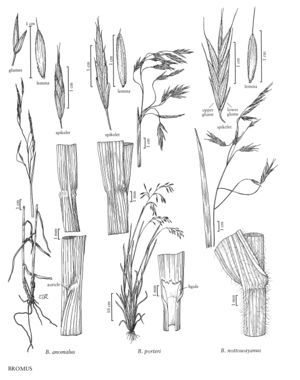Difference between revisions of "Bromus nottowayanus"
FNA>Volume Importer |
imported>Volume Importer |
||
| (4 intermediate revisions by 2 users not shown) | |||
| Line 4: | Line 4: | ||
|publications= | |publications= | ||
|common_names=Virginia brome | |common_names=Virginia brome | ||
| + | |special_status={{Treatment/ID/Special_status | ||
| + | |code=E | ||
| + | |label=Endemic | ||
| + | }} | ||
|basionyms= | |basionyms= | ||
|synonyms= | |synonyms= | ||
| Line 17: | Line 21: | ||
-->{{Treatment/Body | -->{{Treatment/Body | ||
|distribution=Kans.;Tenn.;Md.;Mich.;Mo.;N.C.;Ga.;Iowa;Ala.;Ark.;Ind.;N.J.;Okla.;Tex.;N.Y.;Va.;Ill.;Ont.;Ky.;Ohio | |distribution=Kans.;Tenn.;Md.;Mich.;Mo.;N.C.;Ga.;Iowa;Ala.;Ark.;Ind.;N.J.;Okla.;Tex.;N.Y.;Va.;Ill.;Ont.;Ky.;Ohio | ||
| − | |discussion=<p>Bromus nottowayanus is native to the east-central and eastern United States from Iowa to New York, south to Oklahoma, northern Alabama, and Virginia. It grows in damp, shaded woods, often in ravines and along streams.</p> | + | |discussion=<p><i>Bromus nottowayanus</i> is native to the east-central and eastern United States from Iowa to New York, south to Oklahoma, northern Alabama, and Virginia. It grows in damp, shaded woods, often in ravines and along streams.</p> |
|tables= | |tables= | ||
|references= | |references= | ||
| Line 26: | Line 30: | ||
-->{{#Taxon: | -->{{#Taxon: | ||
name=Bromus nottowayanus | name=Bromus nottowayanus | ||
| − | |||
|authority=Fernald | |authority=Fernald | ||
|rank=species | |rank=species | ||
| Line 34: | Line 37: | ||
|family=Poaceae | |family=Poaceae | ||
|illustrator=Cindy Roché | |illustrator=Cindy Roché | ||
| + | |illustration copyright=Utah State University | ||
|distribution=Kans.;Tenn.;Md.;Mich.;Mo.;N.C.;Ga.;Iowa;Ala.;Ark.;Ind.;N.J.;Okla.;Tex.;N.Y.;Va.;Ill.;Ont.;Ky.;Ohio | |distribution=Kans.;Tenn.;Md.;Mich.;Mo.;N.C.;Ga.;Iowa;Ala.;Ark.;Ind.;N.J.;Okla.;Tex.;N.Y.;Va.;Ill.;Ont.;Ky.;Ohio | ||
|reference=None | |reference=None | ||
|publication title= | |publication title= | ||
|publication year= | |publication year= | ||
| − | |special status= | + | |special status=Endemic |
| − | |source xml=https:// | + | |source xml=https://bitbucket.org/aafc-mbb/fna-data-curation/src/200273ad09963decb8fc72550212de541d86569d/coarse_grained_fna_xml/V24/V24_301.xml |
|subfamily=Poaceae subfam. Pooideae | |subfamily=Poaceae subfam. Pooideae | ||
|tribe=Poaceae tribe Bromeae | |tribe=Poaceae tribe Bromeae | ||
Latest revision as of 16:22, 11 May 2021
Plants perennial; not rhizomatous. Culms (60)70-140 cm, erect or spreading; nodes 5-9, pubescent or glabrous, often concealed by the sheaths; internodes usually glabrous. Sheaths usually retrorsely pilose, some¬times glabrous, with a dense line of hairs at the collar, lower sheaths often sericeous; auricles absent; ligules 0.4-1 mm, often hairy, truncate, erose, ciliolate; blades 15-30 cm long, 5-12 mm wide, often shiny yellow-green, flat, abaxial surfaces pilose, adaxial surfaces glabrous or pilose over the veins. Panicles 9-25 cm, open, nodding; branches ascending or spreading, often recurved. Spikelets 18-30 mm, elliptic to lanceolate, terete to moderately laterally compressed, often purplish, with 6-12 florets. Glumes usually pubescent; lower glumes 5.5-8 mm, 1(3)-veined; upper glumes 7-10 mm, 5-veined, often mucronate; lemmas 8-13 mm, elliptic to lanceolate, rounded over the midvein, usually uniformly densely hairy, or the backs less densely so, apices acute to obtuse, entire; awns 5-8 mm, straight, arising less than 1.5 mm below the lemma apices; anthers 2.8-3.5(5) mm. 2n = 14.
Distribution
Kans., Tenn., Md., Mich., Mo., N.C., Ga., Iowa, Ala., Ark., Ind., N.J., Okla., Tex., N.Y., Va., Ill., Ont., Ky., Ohio
Discussion
Bromus nottowayanus is native to the east-central and eastern United States from Iowa to New York, south to Oklahoma, northern Alabama, and Virginia. It grows in damp, shaded woods, often in ravines and along streams.
Selected References
None.
